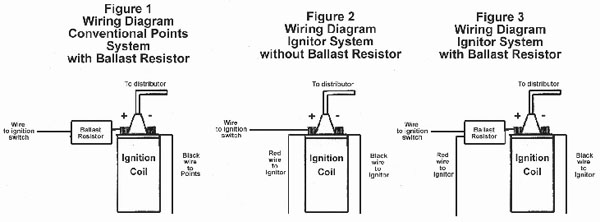
| Many members are trashing their old points in favor of a nice innovation made by Petronix that allows the use of a totally solid state system right under the cap of a stock distributor. AND the nice thing is that you can carry your points in your tool box in case this system ever fails. Recently I installed one on our 351 Windsor located under the hood of our 1972 Ranch Wagon. The Jolly Green Giant.
Anyhow here are the simple instructions... 1. Remove the distributor cap and rotor. Do not disconnect the spark plug wires from the cap. Examine the cap and rotor for wear or damage and replace as needed. (I opt for the distributor caps that have BRASS contacts rather than the ALUMINUM ones) 2. Disconnect the points wire from the negative (-) side of the coil. 3. Remove the points, condenser and grommet. 4. The Ignitor does not require any modification to the distributor, therefor the points, condenser and hardware can be used as backup. 5. Clean any oil or dirt from the breaker plate and cam. 6. Insert the Ignitor black and red wires through the distributor housing verifying the grommet is seated properly. 7. Install the Ignitor module using the provided hardware in the same manner as a set of points. NOTE: 1281 kits use the points adjustment screw hole as the pilot for the Ignitor locating pin. Confirm the mounting plate is flat and fits without any drilling, cutting, or extra hardware. When the correct kit is installed modifications are not needed. 8. If the distributor ground wire was removed during the installation process be sure it is re-attached securely. 9. Place the magnet sleeve down onto the distributor shaft. Rotate the sleeve until you feel the cam line up correctly. Push down firmly until seated. 10. Set the air gap between the module and the magnet sleeve using the provided plastic feeler gauge (0.0130” thick). This is done in the same manner as points. Note: In some kits the modules are stationary and do not require air gapping. 11. Replace rotor and distributor cap. All spark plug wires should be seated securely. 12. Connect the red wire from the Ignitor module to the positive (+) side of the coil, or a 12 volt switching power source. Connect the black wire to the negative (-) side of the coil. Caution: Do not reverse the wires. This will destroy the Ignitor module. 13. The engine can now be started. Let the engine run a few minutes then set timing in the conventional manner. A. Check to make sure you attached the wires to the proper terminals.
Q. The engine still will not start or runs rough. Are there tests I can do?
Q. How can I fix a low voltage problem?
Q. What type of coil do I need?
Q. How do I check my coil for resistance?
Q. What do I do if my coil does not have enough resistance?
Q. What happens if I leave the ignition on when the engine is not running?
Q. May I modify the length of the Ignitor wires? |
